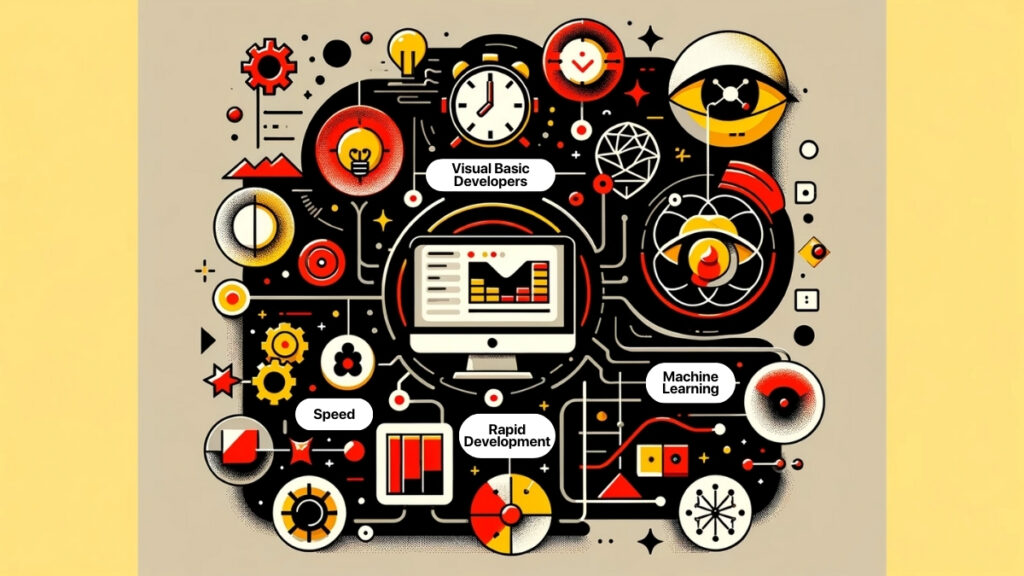The integration of Machine Learning (ML) into .NET represents a significant stride in the evolution of application development. The introduction of ML.NET, Microsoft’s open-source and cross-platform machine learning framework, has enriched the .NET ecosystem with robust machine learning capabilities, expanding accessibility to a wider range of developers, including those skilled in Visual Basic.
Understanding Machine Learning in the .NET Context
Machine learning in .NET, primarily through ML.NET, opens up a realm of possibilities for developers. ML.NET is a framework specifically designed to provide .NET developers, who traditionally worked with languages like C#, F#, and Visual Basic, the tools to integrate machine learning into their applications without needing to learn a new set of skills or languages.
Key Features of ML.NET
- Cross-Platform Compatibility: ML.NET operates seamlessly across multiple platforms, including Windows, Linux, and macOS, allowing developers to build and deploy machine learning models in diverse environments.
- Integration with .NET Languages: It offers native support for .NET languages, enabling Visual Basic and C# developers to utilize their existing coding skills and resources in machine learning projects.
- Versatile ML Capabilities: The framework supports various machine learning tasks such as classification, regression, clustering, and anomaly detection, offering flexibility in application development.
- Use of Existing .NET Libraries: Developers can leverage the rich set of .NET libraries and tools they are familiar with, ensuring a smooth transition into machine learning projects.
- Automated Machine Learning (AutoML): ML.NET includes AutoML features, which automate the process of selecting the best machine learning algorithms and tuning their parameters, simplifying model development.
Practical Applications in the .NET Ecosystem
The practical applications of machine learning in the .NET ecosystem are vast. From enhancing web applications with predictive analytics to building sophisticated AI-driven desktop applications, the scope is immense. For instance, ML.NET has been utilized in scenarios like sentiment analysis, product recommendation systems, and even complex image and speech recognition tasks.
The Synergy of Visual Basic and ML.NET
For Visual Basic developers, ML.NET offers a unique opportunity to enter the world of machine learning without the steep learning curve traditionally associated with AI and ML technologies. They can now build and integrate sophisticated machine learning models directly into their existing Visual Basic applications, leveraging their existing knowledge of the .NET framework.
ML.NET: Bridging Visual Basic and AI
ML.NET stands as a pivotal bridge between the world of Visual Basic and the rapidly advancing field of Artificial Intelligence (AI). This framework, specifically tailored for the .NET ecosystem, is a game-changer for developers who are keen on integrating machine learning capabilities into their applications, without diverging from the .NET environment they are familiar with.
What Makes ML.NET Unique?
- Accessibility: ML.NET is designed to be approachable for developers with varying levels of experience in machine learning. It lowers the barrier to entry, allowing more developers to explore AI capabilities.
- Custom ML Model Development: Unlike other machine learning frameworks that require extensive knowledge of specific languages or tools, ML.NET enables developers to build custom ML models directly within the .NET ecosystem.
- Integration with Visual Basic: One of the standout features of ML.NET is its integration with Visual Basic. This allows developers who have traditionally worked with Visual Basic to step into the realm of machine learning without having to learn a new programming language.
- Diverse Application Scenarios: ML.NET caters to a wide range of machine learning scenarios, including but not limited to, text classification, recommendation systems, and anomaly detection, making it a versatile tool for various applications.
Leveraging ML.NET in Visual Basic
Visual Basic developers can leverage ML.NET to add machine learning functionalities to their existing applications. This includes integrating models for predictive analytics, classification, and other machine learning tasks directly into Visual Basic codebases. The process is streamlined, thanks to the compatibility and tools provided by ML.NET, ensuring a smooth integration with existing .NET applications.
ML.NET’s Model Builder: A Key Tool
A notable feature of ML.NET is the Model Builder, a user-friendly interface that guides developers through the process of building and training machine learning models. This tool simplifies the model creation process, making it more accessible to developers who may not have a deep background in machine learning.
Empowering Visual Basic Developers
The advent of ML.NET opens up new horizons for Visual Basic developers. It enables them to enhance their applications with the power of machine learning, thereby creating more intelligent, efficient, and user-centric applications. With ML.NET, Visual Basic developers are equipped to stay at the forefront of technological advancements in AI, while continuing to work within the familiar .NET framework.
Seamless Integration with Visual Basic

The integration of machine learning into Visual Basic applications via ML.NET is a transformative development for programmers in the .NET ecosystem. This integration enables the incorporation of complex machine learning functionalities into applications with ease and efficiency, leveraging the existing capabilities of Visual Basic.
Effortless Transition into Machine Learning
For Visual Basic developers, transitioning to machine learning with ML.NET is made seamless due to the familiar .NET environment. This compatibility minimizes the learning curve typically associated with venturing into AI and ML. Developers can continue using the same development environment and tools they are accustomed to, ensuring a smooth transition.
Enhancing Visual Basic Applications with ML
By integrating ML.NET, Visual Basic applications can be enhanced with various machine learning features, such as predictive analytics, data classification, and pattern recognition. This opens up possibilities for creating more intelligent and responsive applications, from data-driven business applications to dynamic web services.
Utilizing Visual Basic’s Strengths in ML Projects
Machine learning projects effectively utilize Visual Basic’s strengths in rapid application development, ease of use, and code readability. These attributes make it easier for developers to prototype, build, and deploy ML-enabled applications rapidly.
The Power of Data Transformation
ML.NET facilitates the transformation of data into actionable insights within Visual Basic applications. By processing large volumes of data and learning from it, applications can make informed decisions, automate tasks, and provide personalized user experiences.
ML.NET’s Compatibility with Other Tools
ML.NET’s compatibility with other Microsoft tools and services, such as Azure, further enhances its utility in Visual Basic applications. This integration enables developers to leverage cloud computing, IoT, and other advanced technologies in conjunction with machine learning.
Model Builder: Simplifying Machine Learning
ML.NET’s Model Builder is an essential tool for Visual Basic developers looking to integrate machine learning into their applications. It simplifies the process of building, training, and deploying machine learning models, making machine learning more accessible and manageable.
Overview of Model Builder
Model Builder is a Visual Studio extension that provides a visual interface for building machine learning models. It guides developers through the process of selecting the right machine learning task, training the model, and generating code that can be integrated into Visual Basic applications.
Creating a Machine Learning Model in Visual Basic
To demonstrate the integration of a machine learning model with Visual Basic, let’s consider a simple example: a sentiment analysis model. This model will classify text input as positive or negative sentiment.
- Setting Up: Start by adding the ML.NET Model Builder to your Visual Basic project in Visual Studio.
- Choosing a Scenario: In Model Builder, select the ‘Text Classification’ scenario, suitable for sentiment analysis.
- Data Input: Import your dataset for training the model. This dataset should include text data along with labeled sentiments (positive or negative).
- Training the Model: Model Builder will then guide you through the training process. Specify the column in your dataset that the model should learn from and the one it should predict.
- Evaluating and Using the Model: Once trained, you can evaluate the model’s accuracy. Model Builder will then generate a model file and the necessary code.
- Integrating the Model into Your Application: Finally, add the generated code and model file to your Visual Basic project. You can now use the model to classify new text data.
Sample Code Integration
Here’s a snippet of how you might integrate the trained model into a Visual Basic application:
' Load the trained model
Dim mlContext As New MLContext()
Dim mlModel = mlContext.Model.Load("YourModelPath", dataviewSchema)
' Create a prediction engine
Dim predictionEngine = mlContext.Model.CreatePredictionEngine(Of ModelInput, ModelOutput)(mlModel)
' Use the model for prediction
Dim sampleText As New ModelInput With {.Text = "Your sample text here"}
Dim prediction = predictionEngine.Predict(sampleText)
Console.WriteLine($"Predicted sentiment: {prediction.Prediction}")
In this code, ModelInput and ModelOutput are classes generated by Model Builder, representing the data structure of the input and output of your machine learning model. YourModelPath is the path to the trained model file.
Advantages for Visual Basic Developers

- Ease of Use: The visual interface and guided steps in Model Builder make it easier for developers to experiment with different machine learning models.
- Rapid Development: The automatic generation of code and easy integration allow for quick prototyping and deployment.
- Flexibility: Model Builder supports a range of machine learning tasks, offering flexibility for various application needs.
The Model Builder thus serves as a powerful tool, streamlining the process of integrating machine learning into Visual Basic applications. It embodies the synergy of traditional programming with modern AI, enabling developers to enhance their applications with advanced machine learning capabilities.
Hands-On Machine Learning: From Theory to Practice
After understanding the basics of integrating machine learning into Visual Basic applications using ML.NET Model Builder, it’s essential to delve deeper into the practical aspects of this process. We’ll explore how to build, train, and deploy a custom machine learning model using Visual Basic code.
Building a Custom Machine Learning Model
Let’s create a simple regression model using ML.NET in a Visual Basic application. This model will predict numerical values based on input data. For instance, predicting house prices based on various features like size, location, and age.
- Prepare Your Data: Start with a dataset that includes the features (size, location, age) and the target value (price).
- Setting Up the Environment: Add the necessary ML.NET NuGet packages to your Visual Basic project.
- Loading Data: Use MLContext to load your dataset into the application.
Dim mlContext As New MLContext()
Dim dataView = mlContext.Data.LoadFromTextFile(Of HouseData)("path_to_your_data.csv", hasHeader:=True, separatorChar:=",")
Public Class HouseData
Public Property Size() As Single
Public Property Age() As Single
Public Property Location() As String
Public Property Price() As Single
End Class
- Preparing the Data Pipeline: Specify the transformations and algorithms for data usage.
Dim pipeline = mlContext.Transforms.Categorical.OneHotEncoding("Location") _
.Append(mlContext.Transforms.Concatenate("Features", "Size", "Age", "Location")) _
.Append(mlContext.Regression.Trainers.Sdca(labelColumnName:="Price", featureColumnName:="Features"))
- Training the Model: Train your model using the prepared pipeline.
Dim model = pipeline.Fit(dataView)
- Evaluating the Model: Evaluate the model’s performance with a separate test dataset.
Dim predictions = model.Transform(dataView)
Dim metrics = mlContext.Regression.Evaluate(predictions, labelColumnName:="Price", scoreColumnName:="Score")
Console.WriteLine($"R^2: {metrics.RSquared:0.##}")
Console.WriteLine($"RMS error: {metrics.RootMeanSquaredError:0.##}")
- Deploying the Model: Use the trained model to make predictions on new data.
Dim predictionFunction = mlContext.Model.CreatePredictionEngine(Of HouseData, HousePricePrediction)(model)
Public Class HousePricePrediction
Public Property Score() As Single
End Class
- Making Predictions: Predict the price of a new house.
Dim houseData = New HouseData With {.Size = 750, .Age = 15, .Location = "Urban"}
Dim prediction = predictionFunction.Predict(houseData)
Console.WriteLine($"Predicted price: {prediction.Score}")
Practical Considerations
- Data Quality: The accuracy of predictions depends heavily on the quality and quantity of the training data.
- Model Tuning: Experimenting with different algorithms and parameters is key to improving model performance.
- Deployment Strategy: Consider how the model will be deployed and used in real-world scenarios.
Through this practical example, Visual Basic developers can gain a deeper understanding of building and deploying machine learning models using ML.NET. This hands-on approach not only solidifies the theoretical knowledge but also equips developers with the skills to implement machine learning in their real-world applications.
Future Trends: AI and Machine Learning in .NET
The future of AI and machine learning within the .NET ecosystem, particularly with respect to Visual Basic and other .NET languages, is poised for significant advancements. This evolution is expected to be driven by several key trends and developments in the field.
Enhanced Integration and Accessibility
- Streamlined Machine Learning Tools: We expect that future updates to ML.NET and its associated tools will further streamline machine learning integration for .NET developers. This includes more intuitive interfaces, simplified coding processes, and enhanced automation in model training and deployment.
- Broader Accessibility: As AI and ML become more integral to various industries, there will be a push to make these technologies more accessible to developers with diverse backgrounds, not just those specialized in data science. This means more resources, tutorials, and community support focused on integrating AI into everyday .NET applications.
Advancements in Model Capabilities

- Improved Model Performance: Continuous research and development in AI and machine learning will likely lead to more efficient and accurate models. This could manifest in faster training times, better prediction accuracy, and the ability to handle more complex data sets.
- Expanded Model Types: There is potential for a wider variety of pre-built models and templates to be available for .NET developers. These models could cover more specialized use cases or industry-specific needs, further broadening the scope of ML.NET applications.
Cloud and Edge Computing
- Cloud Integration: Enhanced integration with cloud platforms like Azure is anticipated. This integration will likely provide more powerful computational resources for training complex models and managing large datasets, all accessible within the .NET environment.
- Edge Computing: There’s an increasing trend towards edge computing, where machine learning models run on local devices instead of in the cloud. This shift is particularly relevant for IoT applications and real-time data processing, areas where .NET has a strong presence.
Cross-Platform Development
- Mobile and Cross-Platform Applications: The future of .NET in AI and ML also includes better support for mobile and cross-platform application development. This will allow developers to deploy machine learning models across various platforms and devices seamlessly.
Ethical AI and Responsible Development
- Focus on Ethical AI: As AI becomes more prevalent, there will be a stronger emphasis on developing responsible and ethical AI. This includes ensuring data privacy, avoiding bias in machine learning models, and making AI systems more transparent and accountable.
- Community and Open Source Contributions: The open-source nature of ML.NET encourages community contributions, leading to more diverse and innovative developments in machine learning within the .NET ecosystem.
Conclusion: The Road Ahead for Visual Basic Developers
The integration of machine learning into Visual Basic via platforms like ML.NET is not just a technological advancement; it’s a paradigm shift in how developers approach problem-solving and application development. For Visual Basic developers, this evolution opens up a new vista of opportunities, blending the simplicity and robustness of Visual Basic with the dynamic and evolving world of AI and machine learning. As the .NET ecosystem continues to evolve, embracing these technologies will be key to staying relevant and competitive. The road ahead promises a landscape where traditional coding seamlessly integrates with AI-driven functionalities, enabling developers to create more intelligent, efficient, and user-centric applications.
In the future, Visual Basic developers can actively harness these advancements. The supportive community, comprehensive resources, and Microsoft’s commitment to .NET’s growth ensure that developers have the necessary tools and knowledge at their disposal. Embracing these new capabilities will require a mindset geared towards continuous learning and innovation. However, the core principles of Visual Basic – simplicity, clarity, and efficiency – remain as relevant as ever, serving as a solid foundation for these new endeavors. In essence, the future for Visual Basic developers is not just about adapting to change but about leading it, using their skills to shape the next generation of smart applications.




